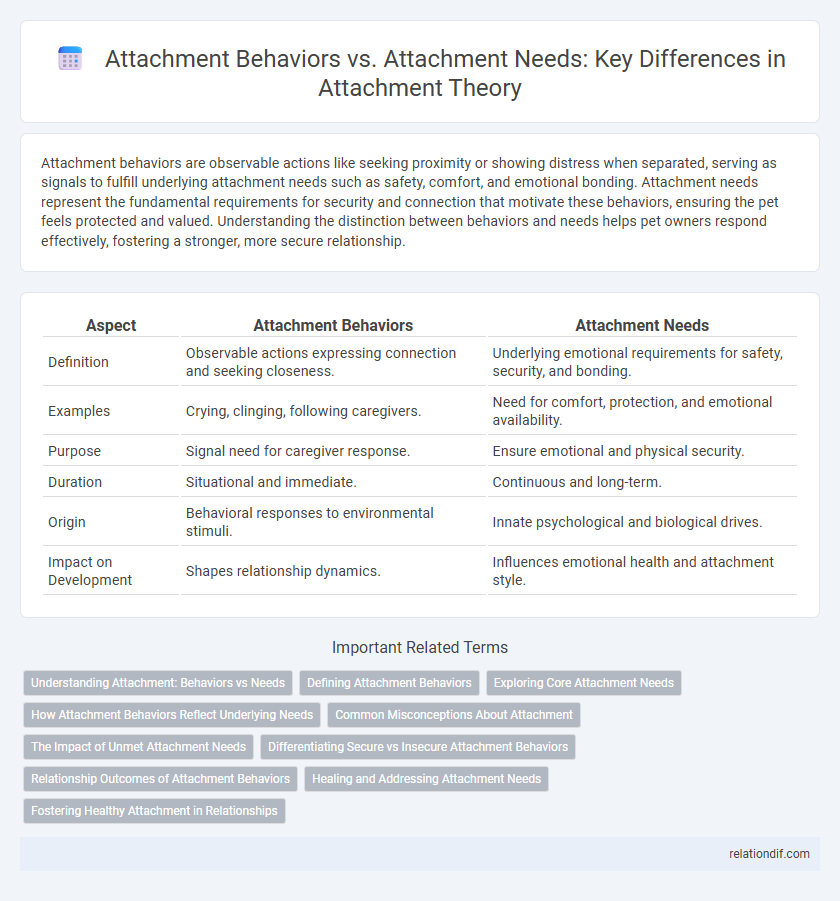Attachment behaviors are observable actions like seeking proximity or showing distress when separated, serving as signals to fulfill underlying attachment needs such as safety, comfort, and emotional bonding. Attachment needs represent the fundamental requirements for security and connection that motivate these behaviors, ensuring the pet feels protected and valued. Understanding the distinction between behaviors and needs helps pet owners respond effectively, fostering a stronger, more secure relationship.
Table of Comparison
| Aspect | Attachment Behaviors | Attachment Needs |
|---|---|---|
| Definition | Observable actions expressing connection and seeking closeness. | Underlying emotional requirements for safety, security, and bonding. |
| Examples | Crying, clinging, following caregivers. | Need for comfort, protection, and emotional availability. |
| Purpose | Signal need for caregiver response. | Ensure emotional and physical security. |
| Duration | Situational and immediate. | Continuous and long-term. |
| Origin | Behavioral responses to environmental stimuli. | Innate psychological and biological drives. |
| Impact on Development | Shapes relationship dynamics. | Influences emotional health and attachment style. |
Understanding Attachment: Behaviors vs Needs
Attachment behaviors are observable actions such as clinging, seeking proximity, or crying that signal a child's desire for security and comfort. Attachment needs refer to the underlying emotional requirements for safety, trust, and connection that drive these behaviors. Differentiating between behaviors and needs helps caregivers respond effectively to foster secure attachments.
Defining Attachment Behaviors
Attachment behaviors are specific actions exhibited by individuals to seek proximity and comfort from a preferred caregiver or attachment figure during times of stress or insecurity. These behaviors include vocalizations, clinging, following, and seeking physical contact, which serve to maintain closeness and ensure safety. Understanding attachment behaviors provides critical insight into the emotional bonds that support secure development and interpersonal relationships.
Exploring Core Attachment Needs
Core attachment needs include safety, security, and emotional connection, which drive attachment behaviors such as seeking proximity or comfort. Attachment behaviors serve as observable actions that help fulfill these underlying psychological needs in relationships. Understanding the distinction between behaviors and needs allows for more effective support of healthy emotional bonds and interpersonal dynamics.
How Attachment Behaviors Reflect Underlying Needs
Attachment behaviors, such as seeking proximity, clinging, and distress upon separation, directly reflect underlying attachment needs for safety, security, and emotional connection. These behaviors serve as communication signals that indicate a child's need for reassurance and comfort from caregivers. Understanding the link between attachment behaviors and needs is crucial for fostering secure relationships and healthy emotional development.
Common Misconceptions About Attachment
Many people mistakenly equate attachment behaviors, such as seeking proximity or showing distress, directly with attachment needs, overlooking that behaviors are expressions rather than the needs themselves. Attachment needs refer to deep-rooted emotional requirements for safety, security, and connection, which may not always manifest in observable behaviors. Understanding this distinction is crucial to accurately addressing attachment-related challenges and promoting healthy relational development.
The Impact of Unmet Attachment Needs
Unmet attachment needs profoundly affect emotional regulation and interpersonal relationships, often leading to heightened anxiety, mistrust, and difficulty forming secure bonds. Attachment behaviors, such as seeking proximity and reassurance, intensify when these needs remain unfulfilled, signaling distress and a cry for connection. Persistent failure to meet attachment needs in early development is linked to long-term challenges in social functioning and mental health disorders including depression and attachment-related anxiety.
Differentiating Secure vs Insecure Attachment Behaviors
Secure attachment behaviors include seeking comfort from caregivers during distress, showing trust, and effectively communicating needs, reflecting a stable emotional bond. Insecure attachment behaviors often involve avoidance, ambivalence, or resistance to caregiver comfort, indicating inconsistent or unresponsive caregiving. Differentiating these behaviors reveals underlying attachment needs, where secure attachments satisfy needs for safety and connection, while insecure attachments highlight unmet needs for reliability and emotional support.
Relationship Outcomes of Attachment Behaviors
Attachment behaviors directly influence relationship outcomes by fostering security and trust between individuals, enhancing emotional bonding and conflict resolution. These behaviors, such as seeking proximity and providing comfort, fulfill attachment needs and promote relationship stability and satisfaction. Consistent attachment behaviors contribute to the development of secure attachment styles, which correlate with positive interpersonal outcomes like increased intimacy and effective communication.
Healing and Addressing Attachment Needs
Attachment behaviors are observable actions aimed at gaining proximity and reassurance from caregivers, while attachment needs refer to the underlying emotional requirements for security and connection. Healing involves identifying and nurturing these unmet attachment needs through consistent, responsive caregiving or therapeutic interventions that foster trust and emotional regulation. Addressing attachment needs promotes resilience by supporting the development of secure attachment patterns and mitigating the long-term effects of attachment disruptions.
Fostering Healthy Attachment in Relationships
Attachment behaviors such as seeking proximity, maintaining physical contact, and showing distress upon separation reflect underlying attachment needs, including security, comfort, and emotional connection. Fostering healthy attachment in relationships requires recognizing these behaviors as expressions of fundamental needs and responding consistently with empathy and support. Secure attachment promotes emotional resilience, trust, and long-term intimacy, essential for relational well-being.
Attachment Behaviors vs Attachment Needs Infographic

 relationdif.com
relationdif.com